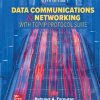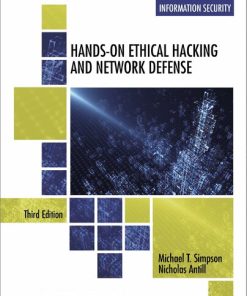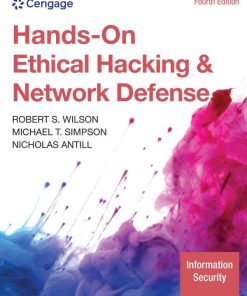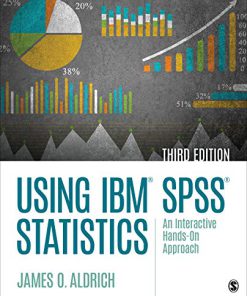(EBook PDF) Hands on Hacking Become an Expert at Next Gen Penetration Testing and Purple Teaming 1st Edition by Matthew Hickey 1119561450 978-1119561453 full chapters
$50.00 Original price was: $50.00.$25.00Current price is: $25.00.
Hands on Hacking: Become an Expert at Next Gen Penetration Testing and Purple Teaming 1st Edition by Matthew Hickey – Ebook PDF Instant Download/DeliveryISBN: 1119561450, 978-1119561453
Full download Hands on Hacking: Become an Expert at Next Gen Penetration Testing and Purple Teaming 1st Edition after payment
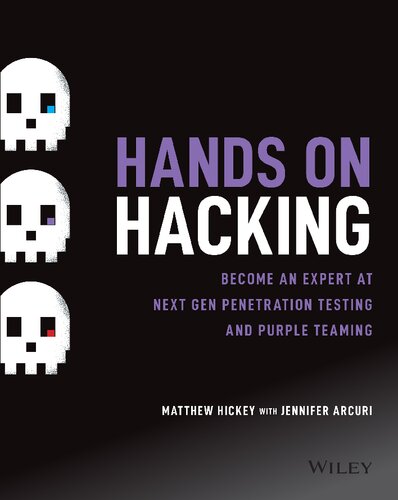
Product details:
ISBN-10 : 1119561450
ISBN-13 : 978-1119561453
Author: Matthew Hickey
A fast, hands-on introduction to offensive hacking techniques
Hands-On Hacking teaches readers to see through the eyes of their adversary and apply hacking techniques to better understand real-world risks to computer networks and data. Readers will benefit from the author’s years of experience in the field hacking into computer networks and ultimately training others in the art of cyber-attacks. This book holds no punches and explains the tools, tactics and procedures used by ethical hackers and criminal crackers alike.
We will take you on a journey through a hacker’s perspective when focused on the computer infrastructure of a target company, exploring how to access the servers and data. Once the information gathering stage is complete, you’ll look for flaws and their known exploits―including tools developed by real-world government financed state-actors.
Hands on Hacking: Become an Expert at Next Gen Penetration Testing and Purple Teaming 1st Table of contents:
Chapter 1 Hacking a Business Case 1
All Computers are Broken 2
The Stakes 4
What’s Stolen and Why It’s Valuable 4
The Internet of Vulnerable Things 4
Blue, Red, and Purple Teams 5
Blue Teams 5
Red Teams 5
Purple Teams 7
Hacking is Part of Your Company’s Immune System 9
Summary 11
Notes 12
Chapter 2 Hacking Ethically and Legally 13
Laws That Affect Your Work 14
Criminal Hacking 15
Hacking Neighborly 15
Legally Gray 16
Penetration Testing Methodologies 17
Authorization 18
Responsible Disclosure 19
Bug Bounty Programs 20
Legal Advice and Support 21
Hacker House Code of Conduct 22
Summary 22
Chapter 3 Building Your Hack Box 23
Hardware for Hacking 24
Linux or BSD? 26
Host Operating Systems 27
Gentoo Linux 27
Arch Linux 28
Debian 28
Ubuntu 28
Kali Linux 29
Verifying Downloads 29
Disk Encryption 31
Essential Software 33
Firewall 34
Password Manager 35
Email 36
Setting Up VirtualBox 36
Virtualization Settings 37
Downloading and Installing VirtualBox 37
Host-Only Networking 37
Creating a Kali Linux VM 40
Creating a Virtual Hard Disk 42
Inserting a Virtual CD 43
Virtual Network Adapters 44
Labs 48
Guest Additions 51
Testing Your Virtual Environment 52
Creating Vulnerable Servers 53
Summary 54
Chapter 4 Open Source Intelligence Gathering 55
Does Your Client Need an OSINT Review? 56
What are You Looking For? 57
Where Do You Find It? 58
OSINT Tools 59
Grabbing Email Addresses from Google 59
Google Dorking the Shadows 62
A Brief Introduction to Passwd and Shadow Files 62
The Google Hacking Database 65
Have You Been “Pwned” Yet? 66
OSINT Framework Recon-ng 67
Recon-ng Under the Hood 74
Harvesting the Web 75
Document Metadata 76
Maltego 80
Social Media Networks 81
Shodan 83
Protecting Against OSINT 85
Summary 86
Chapter 5 The Domain Name System 87
The Implications of Hacking DNS 87
A Brief History of DNS 88
The DNS Hierarchy 88
A Basic DNS Query 89
Authority and Zones 92
DNS Resource Records 92
BIND9 95
DNS Hacking Toolkit 98
Finding Hosts 98
WHOIS 98
Brute-Forcing Hosts with Recon-ng 100
Host 101
Finding the SOA with Dig 102
Hacking a Virtual Name Server 103
Port Scanning with Nmap 104
Digging for Information 106
Specifying Resource Records 108
Information Leak CHAOS 111
Zone Transfer Requests 113
Information-Gathering Tools 114
Fierce 115
Dnsrecon 116
Dnsenum 116
Searching for Vulnerabilities and Exploits 118
Searchsploit 118
Other Sources 119
DNS Traffic Amplification 120
Metasploit 121
Carrying Out a Denial-of-Service Attack 125
DoS Attacks with Metasploit 126
DNS Spoofi ng 128
DNS Cache Poisoning 129
DNS Cache Snooping 131
DNSSEC 131
Fuzzing 132
Summary 134
Chapter 6 Electronic Mail 135
The Email Chain 135
Message Headers 137
Delivery Status Notifications 138
The Simple Mail Transfer Protocol 141
Sender Policy Framework 143
Scanning a Mail Server 145
Complete Nmap Scan Results (TCP) 149
Probing the SMTP Service 152
Open Relays 153
The Post Office Protocol 155
The Internet Message Access Protocol 157
Mail Software 158
Exim 159
Sendmail 159
Cyrus 160
PHP Mail 160
Webmail 161
User Enumeration via Finger 162
Brute-Forcing the Post Office 167
The Nmap Scripting Engine 169
CVE-2014-0160: The Heartbleed Bug 172
Exploiting CVE-2010-4345 180
Got Root? 183
Upgrading Your Shell 184
Exploiting CVE-2017-7692 185
Summary 188
Chapter 7 The World Wide Web of Vulnerabilities 191
The World Wide Web 192
The Hypertext Transfer Protocol 193
HTTP Methods and Verbs 195
HTTP Response Codes 196
Stateless 198
Cookies 198
Uniform Resource Identifiers 200
LAMP: Linux, Apache, MySQL, and PHP 201
Web Server: Apache 202
Database: MySQL 203
Server-Side Scripting: PHP 203
Nginx 205
Microsoft IIS 205
Creepy Crawlers and Spiders 206
The Web Server Hacker’s Toolkit 206
Port Scanning a Web Server 207
Manual HTTP Requests 210
Web Vulnerability Scanning 212
Guessing Hidden Web Content 216
Nmap 217
Directory Busting 218
Directory Traversal Vulnerabilities 219
Uploading Files 220
WebDAV 220
Web Shell with Weevely 222
HTTP Authentication 223
Common Gateway Interface 225
Shellshock 226
Exploiting Shellshock Using Metasploit 227
Exploiting Shellshock with cURL and Netcat 228
SSL, TLS, and Heartbleed 232
Web Administration Interfaces 238
Apache Tomcat 238
Webmin 240
phpMyAdmin 241
Web Proxies 242
Proxychains 243
Privilege Escalation 245
Privilege Escalation Using DirtyCOW 246
Summary 249
Chapter 8 Virtual Private Networks 251
What is a VPN? 251
Internet Protocol Security 253
Internet Key Exchange 253
Transport Layer Security and VPNs 254
User Databases and Authentication 255
SQL Database 255
RADIUS 255
LDAP 256
PAM 256
TACACS+ 256
The NSA and VPNs 257
The VPN Hacker’s Toolkit 257
VPN Hacking Methodology 257
Port Scanning a VPN Server 258
Hping3 259
UDP Scanning with Nmap 261
IKE-scan 262
Identifying Security Association Options 263
Aggressive Mode 265
OpenVPN 267
LDAP 275
OpenVPN and Shellshock 277
Exploiting CVE-2017-5618 278
Summary 281
Chapter 9 Files and File Sharing 283
What is Network-Attached Storage? 284
File Permissions 284
NAS Hacking Toolkit 287
Port Scanning a File Server 288
The File Transfer Protocol 289
The Trivial File Transfer Protocol 291
Remote Procedure Calls 292
RPCinfo 294
Server Message Block 295
NetBIOS and NBT 296
Samba Setup 298
Enum4Linux 299
SambaCry (CVE-2017-7494) 303
Rsync 306
Network File System 308
NFS Privilege Escalation 309
Searching for Useful Files 311
Summary 312
Chapter 10 UNIX 315
UNIX System Administration 316
Solaris 316
UNIX Hacking Toolbox 318
Port Scanning Solaris 319
Telnet 320
Secure Shell 324
RPC 326
CVE-2010-4435 329
CVE-1999-0209 329
CVE-2017-3623 330
Hacker’s Holy Grail EBBSHAVE 331
EBBSHAVE Version 4 332
EBBSHAVE Version 5 335
Debugging EBBSHAVE 335
R-services 338
The Simple Network Management Protocol 339
Ewok 341
The Common UNIX Printing System 341
The X Window System 343
Cron and Local Files 347
The Common Desktop Environment 351
EXTREMEPARR 351
Summary 353
Chapter 11 Databases 355
Types of Databases 356
Flat-File Databases 356
Relational Databases 356
Nonrelational Databases 358
Structured Query Language 358
User-Defined Functions 359
The Database Hacker’s Toolbox 360
Common Database Exploitation 360
Port Scanning a Database Server 361
MySQL 362
Exploring a MySQL Database 362
MySQL Authentication 373
PostgreSQL 374
Escaping Database Software 377
Oracle Database 378
MongoDB 381
Redis 381
Privilege Escalation via Databases 384
Summary 392
Chapter 12 Web Applications 395
The OWASP Top 10 396
The Web Application Hacker’s Toolkit 397
Port Scanning a Web Application Server 397
Using an Intercepting Proxy 398
Setting Up Burp Suite Community Edition 399
Using Burp Suite Over HTTPS 407
Manual Browsing and Mapping 412
Spidering 415
Identifying Entry Points 418
Web Vulnerability Scanners 418
Zed Attack Proxy 419
Burp Suite Professional 420
Skipfish 421
Finding Vulnerabilities 421
Injection 421
SQL Injection 422
SQLmap 427
Drupageddon 433
Protecting Against SQL Injection 433
Other Injection Flaws 434
Broken Authentication 434
Sensitive Data Exposure 436
XML External Entities 437
CVE-2014-3660 437
Broken Access Controls 439
Directory Traversal 440
Security Misconfiguration 441
Error Pages and Stack Traces 442
Cross-Site Scripting 442
The Browser Exploitation Framework 445
More about XSS Flaws 450
XSS Filter Evasion 450
Insecure Deserialization 452
Known Vulnerabilities 453
Insufficient Logging and Monitoring 453
Privilege Escalation 454
Summary 455
Chapter 13 Microsoft Windows 457
Hacking Windows vs. Linux 458
Domains, Trees, and Forests 458
Users, Groups, and Permissions 461
Password Hashes 461
Antivirus Software 462
Bypassing User Account Control 463
Setting Up a Windows VM 464
A Windows Hacking Toolkit 466
Windows and the NSA 467
Port Scanning Windows Server 467
Microsoft DNS 469
Internet Information Services 470
Kerberos 471
Golden Tickets 472
NetBIOS 473
LDAP 474
Server Message Block 474
ETERNALBLUE 476
Enumerating Users 479
Microsoft RPC 489
Task Scheduler 497
Remote Desktop 497
The Windows Shell 498
PowerShell 501
Privilege Escalation with PowerShell 502
PowerSploit and AMSI 503
Meterpreter 504
Hash Dumping 505
Passing the Hash 506
Privilege Escalation 507
Getting SYSTEM 508
Alternative Payload Delivery Methods 509
Bypassing Windows Defender 512
Summary 514
Chapter 14 Passwords 517
Hashing 517
The Password Cracker’s Toolbox 519
Cracking 519
Hash Tables and Rainbow Tables 523
Adding Salt 525
Into the /etc/shadow 526
Different Hash Types 530
MD5 530
SHA-1 531
SHA-2 531
SHA256 531
SHA512 531
bcrypt 531
CRC16/CRC32 532
PBKDF2 532
Collisions 533
Pseudo-hashing 533
Microsoft Hashes 535
Guessing Passwords 537
The Art of Cracking 538
Random Number Generators 539
Summary 540
Chapter 15 Writing Reports 543
What is a Penetration Test Report? 544
Common Vulnerabilities Scoring System 545
Attack Vector 545
Attack Complexity 546
Privileges Required 546
User Interaction 547
Scope 547
Confidentiality, Integrity, and Availability Impact 547
Report Writing as a Skill 549
What Should a Report Include? 549
Executive Summary 550
Technical Summary 551
Assessment Results 551
Supporting Information 552
People also search for Hands on Hacking: Become an Expert at Next Gen Penetration Testing and Purple Teaming 1st:
expert hackers
hacking expert
ex hackers
expert hacker
no hacking
Tags:
Hands,Hacking,an Expert,Gen Penetration,Testing,Purple Teaming,Matthew Hickey
You may also like…
Engineering - Computer Technology
Computers & Technology
Computers - Programming
Computers - Networking
Computers - Programming
Hands-on Test-Driven Development: Using Ruby, Ruby on Rails, and RSpec 1st Edition Greg Donald
Computers - Web Development
Business & Economics


